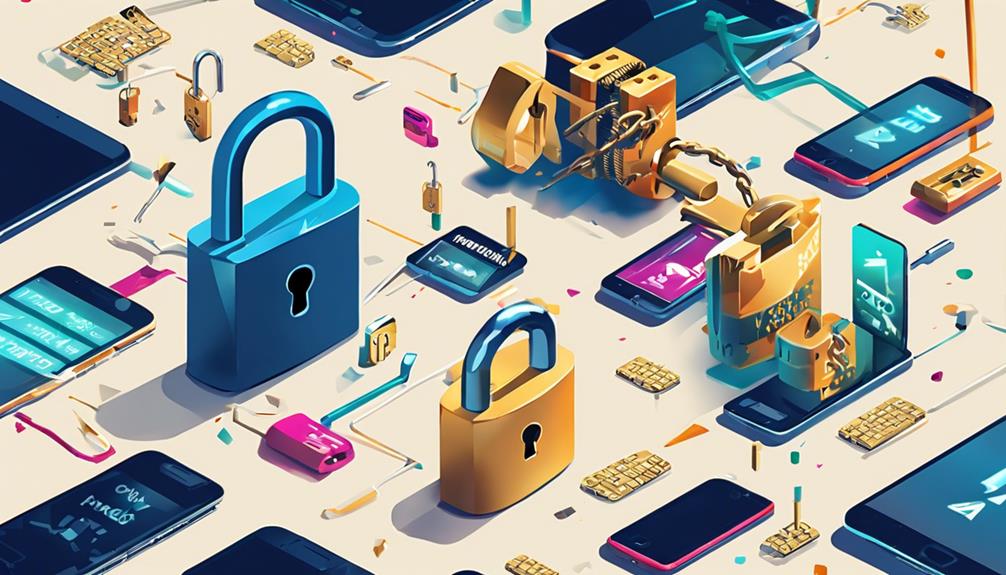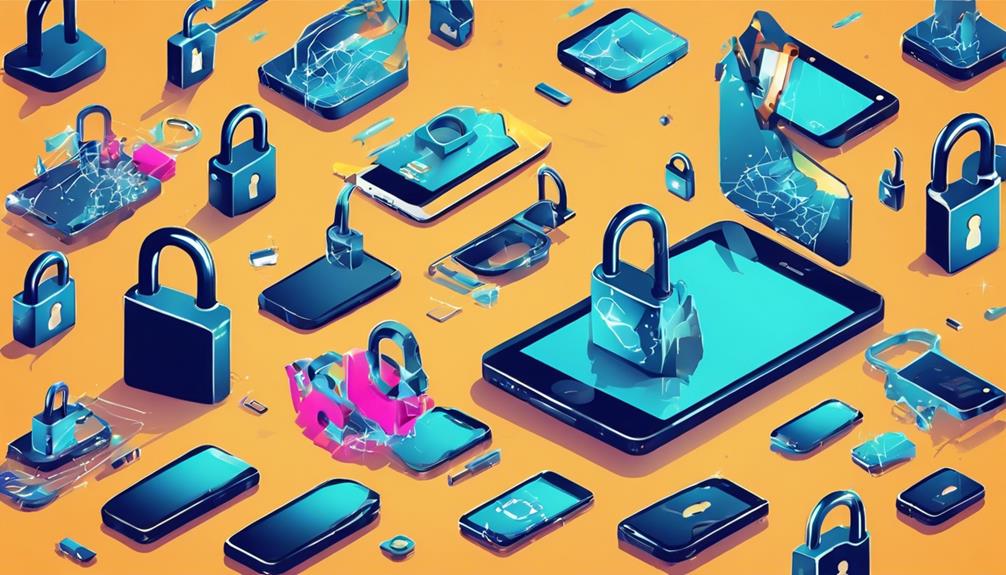Weak passwords can have serious consequences, exposing you to identity theft, financial loss, and privacy breaches. With 81% of data breaches involving weak passwords, the risks are high. Financially, victims face an average loss of $1,343 and spend substantial time resolving issues. Beyond money, the emotional toll is significant, with stress, anxiety, and feelings of violation common. To protect yourself, use strong, unique passwords, and consider multi-factor authentication. Prioritize security to avoid devastating outcomes. Understanding the importance of password strength is crucial. Strengthen your defenses and secure sensitive information from potential harm.
Key Takeaways
- Weak passwords enable easy unauthorized access to personal and financial information.
- Identity theft risks, financial loss, and emotional distress are consequences of weak passwords.
- Strong passwords are crucial for cybersecurity and protection against data breaches.
- Implement multi-factor authentication to enhance security and prevent unauthorized access.
- Regularly update passwords and avoid common, easily guessable ones to mitigate risks.
The Dangers of Weak Passwords
Exposing oneself to significant cybersecurity risks, weak passwords have become a prevalent vulnerability in today's digital landscape. With 81% of data breaches involving stolen or weak passwords, the dangers of using easily guessable passwords like '123456' or 'password' are evident. These common passwords make it effortless for hackers to gain unauthorized access, leading to potential financial repercussions.
The average cost of a data breach is $148 per record, underscoring the financial impact weak passwords can have on individuals and businesses alike. Moreover, breached companies often underperform the market by -15.58%, emphasizing the long-term consequences of inadequate password security.
To mitigate these risks, implementing strong password policies and educating users on password best practices are essential steps in safeguarding sensitive information. By encouraging the use of complex, unique passwords and regular password changes, organizations can notably reduce the likelihood of falling victim to the devastating consequences of weak passwords.
Impact of Identity Theft

Identity theft, a pervasive and damaging crime in today's digital world, poses significant financial, emotional, and legal consequences for its victims. When sensitive information such as passwords or data falls into the wrong hands, the effects can be devastating. Here is a breakdown of the impact of identity theft:
| Consequence | Impact |
|---|---|
| Financial Losses | Average stolen amount in 2020: $1,343 per victim |
| Time and Money Spent | Victims spend 200 hours and $1,400 on average to resolve their cases |
| Credit Score Damage | Difficulty securing loans or mortgages due to damaged credit scores |
| Legal Ramifications | Fraudulent activities may lead to criminal charges against the victim |
Identity theft not only results in monetary losses but also causes emotional distress. Victims often experience stress, anxiety, and a sense of violation, highlighting the significant repercussions of this crime. It is important to protect sensitive information to prevent falling victim to identity theft.
Financial Loss Risks

Essential passwords pose a significant threat to financial stability, with breaches carrying substantial global costs and potential market underperformance. The global average cost of a breach stemming from weak passwords is $3.86 million, highlighting the severe financial implications.
Companies that fall victim to breaches due to weak passwords may underperform the market by -15.58%, showcasing the detrimental effects on financial performance. Additionally, the average cost of a breach per record is $148, emphasizing the financial risks associated with compromised passwords.
Privileged accounts are particularly vulnerable, with 44% of data breaches in 2018 involving these accounts, potentially leading to significant financial repercussions. The consequences of breaches caused by weak passwords can extend beyond monetary losses, resulting in the loss of customers, intellectual property, and legal ramifications like lawsuits, further impacting overall financial stability.
It is essential for individuals and organizations to prioritize strong password practices to mitigate these financial loss risks effectively.
Privacy Breach Consequences

Privacy breaches can have severe ramifications, impacting individuals and organizations in various detrimental ways. When personal accounts are compromised due to a breach, the consequences can be devastating. Loss of personal information and financial data can lead to identity theft, fraud, and unauthorized access to sensitive accounts.
Beyond the immediate impact on individuals, data breaches can also result in reputational damage, legal issues, and financial repercussions for organizations. The aftermath of a privacy breach can leave individuals experiencing emotional distress, anxiety, and a profound sense of violation.
To mitigate the risks associated with privacy breaches, it is imperative to take proactive measures such as using strong, unique passwords and enabling two-factor authentication. By prioritizing the security of personal accounts and sensitive information, individuals can greatly reduce the likelihood of falling victim to the severe consequences of a privacy breach.
Unauthorized Account Access

- Human Error: Individuals often fall prey to using easily guessable passwords, such as '123456' or 'password,' providing hackers with a straightforward path to gain access to their accounts.
- Password Managers: Utilizing password managers can greatly enhance security by generating complex and unique passwords for each account, reducing the risk of unauthorized access through password reuse.
- Potential Consequences: Unauthorized access can lead to severe financial and reputational damage for organizations, with breached companies facing substantial financial losses and a decline in market performance.
Implementing strong password policies, encouraging the use of password managers, and educating users on password security best practices are essential steps to mitigate the risks associated with unauthorized account access and safeguard sensitive information from malicious actors.
Protecting Sensitive Information

Protecting sensitive information through the use of strong and unique passwords is vital in ensuring the security of personal and confidential data. Weak passwords make it easy for hackers to target individuals and gain unauthorized access to their private information.
By using passwords that are easy to remember but difficult for hackers to guess, individuals can keep their data safe from potential breaches. Strong, unique passwords act as a barrier against cyber threats, preventing unauthorized parties from compromising personal and financial well-being.
It is essential to understand that a single weak password can open the door to a cascade of security risks, potentially leading to devastating consequences. Therefore, taking the necessary steps to protect sensitive information with secure passwords is crucial in safeguarding one's digital life.
Importance of Strong Passwords

Strong passwords are a fundamental aspect of cybersecurity, vital for safeguarding sensitive information.
Weak passwords can expose individuals and organizations to significant risks, potentially leading to data breaches and financial losses.
Implementing protection measures like complex passwords and multi-factor authentication is essential in mitigating these threats and ensuring robust security practices.
Password Security Basics
Ensuring robust password security is paramount in safeguarding sensitive information and preventing unauthorized access to accounts.
When it comes to password security basics, here are three key points to keep in mind:
- Avoid Weak Passwords:
Steer clear of passwords that are easily guessable or commonly used. Weak passwords are vulnerable to brute force attacks, where hackers systematically try different combinations to gain access to accounts. Instead, opt for complex passwords with a mix of letters, numbers, and special characters.
- Utilize a Password Management Tool:
Managing multiple strong passwords can be challenging. Consider using a password management tool to securely store and organize your passwords. These tools often offer features like password generation, encryption, and auto-fill to enhance your password security.
- Regularly Update and Change Passwords:
To stay ahead of potential security threats, make it a habit to update your passwords regularly. Changing passwords periodically can help mitigate the risk of unauthorized access and enhance overall account security.
Risks of Weakness
In light of the prevalent risks associated with weak passwords, it becomes essential for individuals to prioritize the adoption of strong password practices to bolster their online security.
Weak passwords are a major culprit in data breaches, accounting for a staggering 81% of incidents. Common passwords like '123456' or 'password' are particularly risky, as they are easily guessed by cybercriminals, leaving accounts vulnerable to attacks. Reusing passwords across multiple accounts amplifies the danger, as compromising one account could potentially lead to unauthorized access to others.
To mitigate these risks, it is vital to use strong, unique passwords for each account. Strong passwords incorporate a mix of characters, making them harder to crack and enhancing security measures. Additionally, changing passwords regularly adds an extra layer of protection against potential disasters.
Protection Measures
Emphasizing the significance of robust password security practices remains paramount in safeguarding sensitive data and online accounts from potential breaches. To enhance protection against cyber threats, consider the following measures:
- Utilize Strong Passwords:
Opt for long, complex passwords with a mix of characters to increase security levels substantially.
- Implement Multi-Factor Authentication:
Adding an extra layer of protection through multi-factor authentication can prevent unauthorized access even if passwords are compromised.
- Enforce Strong Password Policies:
Providing password training to your team and adhering to password guidelines are critical steps in safeguarding personal and sensitive information from breaches.
Strong password policies help in promoting better password habits among employees and reducing the risk of unauthorized access by malicious computer programs attempting to exploit weak passwords in the system.
Frequently Asked Questions
What Are the Dangers of Weak Passwords?
Weak passwords pose significant security risks by being responsible for 81% of data breaches. These breaches not only result in a financial cost of $148 per record but also lead to long-term underperformance for breached companies.
What Are 5 Weak Passwords?
It is essential to choose strong, unique passwords to protect personal and sensitive information, as weak passwords such as '123456,' 'password,' '123456789,' 'qwerty,' and '1234567' are highly vulnerable and commonly used, posing significant security risks.
What Would Happen if You Don't Use Strong Passwords?
Neglecting strong passwords invites cyber threats, leading to compromised data, financial devastation, and reputational harm. It's akin to leaving your house unsecured in a high-crime area—vulnerability exposed, assets at risk, and peace of mind shattered.
What Is One Way to Avoid the Problem of Weak Passwords?
To address the challenge of weak passwords, implementing Two-Factor Authentication is a proactive approach. This security measure adds an extra layer of protection by requiring a secondary verification code, reducing the risk of unauthorized access.
Conclusion
To sum up, the impact of a weak password can have devastating consequences on one's life. Just one simple mistake can lead to identity theft, financial loss, privacy breaches, and unauthorized account access.
It is essential to protect sensitive information by using strong, unique passwords for all accounts. Remember, a weak password is like leaving the door to your life wide open for anyone to walk in and wreak havoc.
Stay vigilant and prioritize your online security to avoid such risks.









